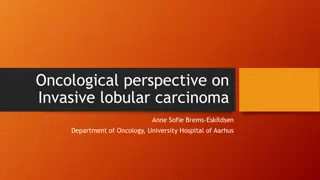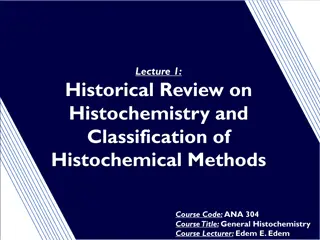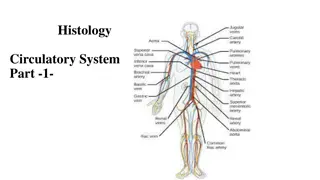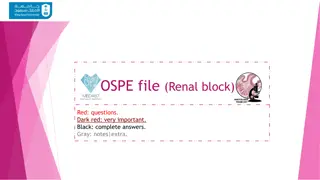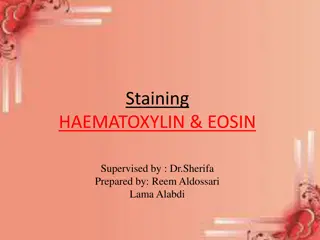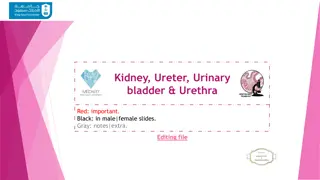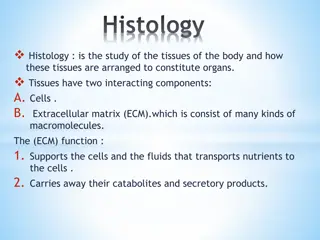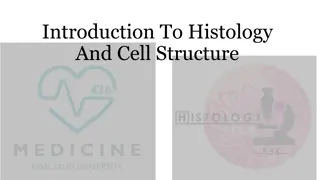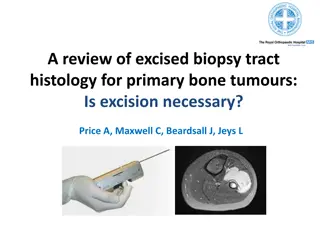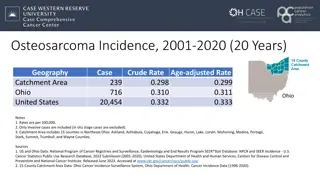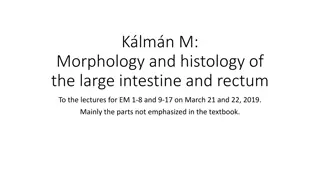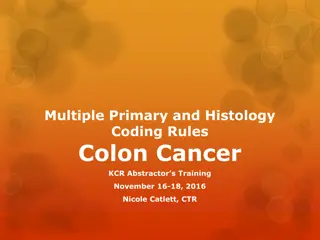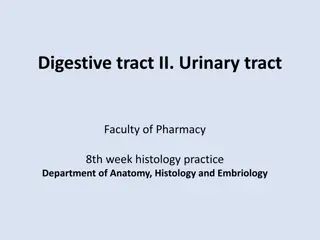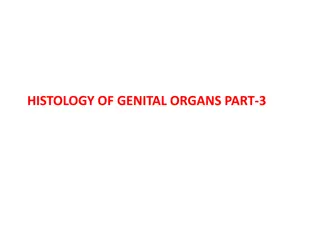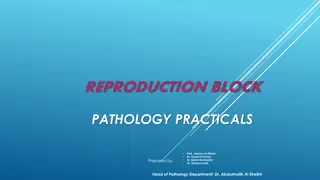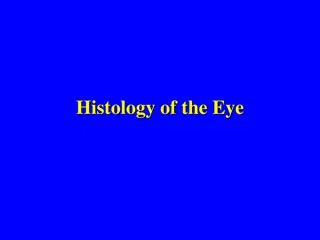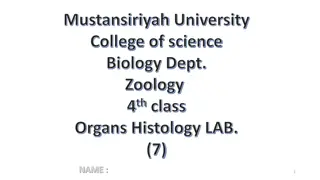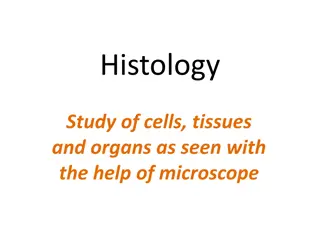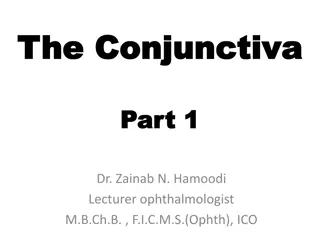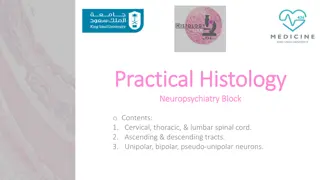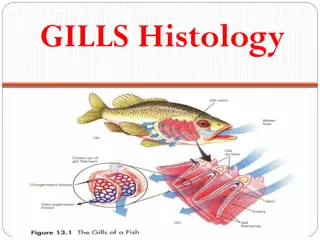Pathology Acute kidney injury
Guidelines of renal biopsy, types of acute kidney injury, clinical manifestations, and pathological findings in this comprehensive lecture. Explore the normal anatomy and histology of the kidney, terminology, etiology, pathophysiology, and more.
7 views • 17 slides
Anatomy of Intestine in Domestic Animals
The intestine in domestic animals plays a vital role in digestion and absorption. It consists of the small intestine for chemical digestion and absorption and the large intestine for water absorption and excretion. This article covers the gross anatomy, histology, and embryology of the intestine, de
2 views • 84 slides
Oncological Perspective on Invasive Lobular Carcinoma: Challenges and Response to Chemotherapy
Guidelines and characteristics of invasive lobular carcinoma, focusing on oncological challenges, response to chemotherapy, and prognosis after neo-adjuvant treatment in patients. Highlights the importance of considering histology type for tailored treatment decisions. Discusses the effectiveness of
0 views • 20 slides
Evolution of Histochemistry: A Journey Through Scientific Breakthroughs
Delve into the historical review of histochemistry, exploring its roots in the assessment of chemical compounds within cells and tissues using stains and dyes. Uncover the classification of histochemical methods, from chemical to biological approaches, and gain insights into the development and goal
0 views • 16 slides
Renal Block Pathology Practical: Anatomy and Histology Overview
The Renal Block Pathology Practical provides a comprehensive insight into the anatomy, structure, and histology of the kidney nephrons, including normal and abnormal conditions such as acute kidney injury. The session covers topics like the structure of the nephron, normal kidney gross anatomy, rena
3 views • 47 slides
Understanding the Circulatory System and Blood Vessels in Histology
The circulatory system, comprising the cardiovascular and lymphatic systems, plays a vital role in transporting essential substances throughout the body. It consists of arteries, veins, capillaries, and the heart. Blood vessels have distinct histological structures with three main layers - intima, m
1 views • 15 slides
Histology of the Renal System for OSPE Exam Preparation
This comprehensive OSPE file for renal block covers key structures of the kidney including the cortex, juxtaglomerular apparatus, renal corpuscle, and kidney medulla. It provides detailed identification of structures, labeling of components, and differentiation between tubules. Helpful images and de
0 views • 11 slides
Parathyroid Carcinoma Misdiagnosed as Thyroid Lesion: A Case Study
Parathyroid carcinoma (PC) is a rare malignancy often challenging to differentiate from benign thyroid nodules. This case study highlights a 50-year-old male patient whose nonfunctioning sporadic PC was initially misidentified as a follicular thyroid nodule. Despite preoperative evaluations, includi
4 views • 27 slides
Understanding H&E Staining in Histology
H&E staining, a widely used histological technique, involves staining cell nuclei blue and cytoplasmic components pink to aid in tissue structure analysis. This method provides essential insights into normal and pathological tissue changes, assisting in diagnoses and further testing decisions. The p
0 views • 7 slides
National Histopathology Service for Organ Retrieval and Transplantation - Audit Findings
The need for a national histopathology service for organ retrieval and transplantation is highlighted, with a focus on the importance of histopathological analysis in assessing donor organ quality and identifying lesions for further investigation. The audit findings show the incidence of urgent hist
0 views • 17 slides
Microscopic Structure and Histology of Kidney and Urinary Tract
Explore the intricate details of kidney anatomy, nephron structure, glomerular filtration barrier, and the histology of renal cortex and medulla, renal corpuscle, proximal and distal tubules, juxtaglomerular apparatus, as well as the urinary bladder and urethra in both male and female. Delve into th
0 views • 17 slides
Understanding the Microscopic Structure and Function of the Pituitary Gland
Explore the detailed histology of the pituitary gland, focusing on its adenohypophysis and neurohypophysis components. Learn about the diverse parenchymal cells, including acidophils, basophils, and chromophobes, and their respective functions in hormone production. Dive into the significance of the
0 views • 6 slides
Introduction to Histology and Microscopy in Anatomy
Histology is the study of tissue structure and function in animals and plants, focusing on the microscopic structure of cells, tissues, and organs. It helps in understanding the relationship between structure and function, intertwining disciplines like cell biology, pathology, physiology, and bioche
0 views • 5 slides
NGM282 in NASH: Phase 2 Study on Liver Fat Reduction and Histology Changes
A phase 2 study on NGM282 in NASH patients showed a significant decrease in liver fat content, meeting the primary endpoint. Exploratory findings also indicated potential improvements in liver histology. The treatment involved NGM282 at 3 mg QD, with additional rosuvastatin if needed. Promising resu
0 views • 11 slides
Overview of Histology: Study of Tissues and Organs
Histology involves studying the tissues of the body and how they form organs. Tissues consist of cells and extracellular matrix, with functions like support, nutrient transport, and waste removal. The human body comprises epithelial, connective, muscular, and nervous tissues, each with specific func
0 views • 4 slides
Introduction to Histology and Cell Structure
Histology is the microscopic study of normal tissues utilizing light and electron microscopes. This field explores the composition and function of cells, focusing on the nucleus, cytoplasm, organelles, and inclusions. Thin tissue sections stained with Haematoxylin and Eosin reveal distinct cellular
0 views • 23 slides
Understanding Tissues: Types, Characteristics, and Functions
Explore the intricate world of histology and tissues, where groups of cells with similar structures and functions come together to support various bodily processes. From epithelial to nerve tissues, delve into the differences in tissue classes, cell types, and extracellular matrices. Discover the un
0 views • 74 slides
Understanding Histology and Cell Structure Fundamentals
Delve into the intriguing world of histology and cell structure, exploring the composition of cells, the functions of various components like the nucleus and cytoplasm, and the significance of organelles. Discover how histology is studied, the types of microscopes used, and the vital role of the cel
0 views • 24 slides
Challenges Faced in Histology Workforce Recruitment and Retention
Shelly Semerad, MA, CT (ASCP), faced challenges in recruiting and retaining histology personnel, leading to overnight positions remaining unfilled for months. Despite standard recruitment efforts and revised offerings, the shortage persisted. The team learned the importance of competitive compensati
0 views • 7 slides
Understanding Epithelial Tissue in General Histology
Epithelial tissue is a crucial type of tissue in the human body, performing functions like protection, absorption, secretion, and sensation detection. This tissue is composed of cells with minimal extracellular matrix and plays a vital role in various bodily processes. Learn about the classification
0 views • 47 slides
Excised Biopsy Tract Histology for Primary Bone Tumours: Necessity of Excision Examined
Investigating the necessity of excising biopsy tracts in primary bone tumours, this study analyzed 278 patients over a span of two years. Findings indicated conflicting evidence regarding the risk of malignant seeding in biopsy tracts, with only one patient showing histological evidence of seeding.
0 views • 14 slides
Osteosarcoma Incidence and Mortality in Ohio, 2001-2020: Data Analysis
Examination of osteosarcoma incidence and mortality rates over two decades in Ohio's 15-county catchment area reveals a crude rate of 0.298-0.333 for incidence and 0.142-0.179 for mortality per 100,000. Data sources include SEER databases, highlighting the challenges in identifying osteosarcoma case
0 views • 9 slides
Anatomy Review: Large Intestine and Rectum Histology
The presentation delves into the detailed morphology and histology of the large intestine and rectum, covering aspects often not emphasized in textbooks. It explores nuances such as the S-shaped structure of the rectum, the composition of the anal canal, the layers of epithelium, and the territorial
1 views • 8 slides
Guidelines for Multiple Primary & Histology Coding in Colon Cancer Abstractor Training
Utilize the Multiple Primary & Histology Coding Rules for accurate case abstraction. Understand equivalent terms, definitions, and instructions to determine multiple primaries for solid malignant tumors diagnosed after January 1, 2007. Avoid relying on physician statements and prioritize following t
0 views • 64 slides
Exploring the Fascinating World of Biology and Human Biology
Biology is a broad scientific field encompassing the study of living organisms and their various aspects, from anatomy and physiology to genetics and evolution. Branches of biology include anatomy, histology, cytology, physiology, embryology, genetics, molecular biology, biochemistry, zoology, botan
0 views • 21 slides
Overview of Jejunum and Ilium Histology and Vascular Supply
The jejunum and ileum are segments of the small intestine with distinct features in terms of position, diameter, wall thickness, and lymphoid aggregates. They receive arterial blood supply from branches of the superior mesenteric artery and drain into various venous tributaries. Histologically, the
0 views • 14 slides
Thyroid Cancer Survival Trends in Europe: Eurocare-5 Study
A population-based study on thyroid cancer survival rates in Europe over 25 years reveals insights by sex, country, age, period, and histological type. The study shows increased incidence but stable mortality trends, with varying survival rates based on region, gender, and histology types like papil
0 views • 14 slides
Histology Overview of Digestive and Urinary Tracts in Pharmacy Practice
This histology practice session delves into the intricate details of the digestive and urinary tracts studied in the 8th week of Pharmacy school. Explore images showcasing the structures of the colon, vermiform appendix, liver, pancreas, and nephron. Gain insights into the histological features of t
0 views • 19 slides
Leading Pathology and Histology Laboratory in Israel
L.E.M Laboratory in Israel, founded in 2001, is a premier facility offering high-quality medical services including Pathology and Histology tests. The lab stands out for its commitment to technology in the field, advanced information systems for efficient management, and stringent quality control me
0 views • 14 slides
Precision Oncology and Genomic Changes in Cancer Treatment
Explore the intricate details of cancer treatment through precision oncology, focusing on cell of origin, genomic changes, tumor microenvironment, host factors, and response to various treatments such as chemotherapy, biological therapy, and immune therapy. The natural history and histology-guided c
0 views • 9 slides
Overview of Special Connective Tissue: Cartilage - Histology by Dr. Ammar Ismail
Cartilage is a specialized connective tissue with chondrocytes in lacunae, lacking vasculature and nerves. Hyaline cartilage is common in the body, while elastic cartilage contains elastic fibers, and fibrocartilage is associated with dense connective tissue. Cartilage growth occurs through chondroc
0 views • 20 slides
Female Ovary Histology and Function Overview
The female reproductive organ, the ovary, plays crucial roles in oocyte development, hormone production, and ovulation. Structurally, ovaries have a cortex and medulla, with follicles containing oocytes and surrounding cells. The primary follicle marks the onset of follicular maturation, leading to
0 views • 12 slides
Male Reproductive System: Testis and Prostate Anatomy and Histology
Explore the normal anatomy and histology of the testis and prostate in the male reproductive system. Detailed images and descriptions provide insights into the structures and functions of these important organs. Understand the gross and microscopic features of the testis, including seminiferous tubu
0 views • 39 slides
Histology of the Eye: Structure and Function Overview
Explore the histology of the eye, covering the general structure and the microscopic details of the cornea and retina. Learn about the three coats of the eye bulb, including the fibrous, vascular, and neural tunics. Dive into the composition of the cornea, from its transparent and highly innervated
0 views • 24 slides
Anatomy and Histology of the Eye: A Comprehensive Study
An in-depth exploration of the anatomy and histology of the eye, covering structures such as the cornea, sclera, choroid, iris, and more. Detailed descriptions of each component, including layers, composition, and functions, are provided alongside accompanying images for visual reference.
0 views • 11 slides
Introduction to Histology: Study of Cells, Tissues, and Organs
Histology, also known as microscopic anatomy, focuses on the study of cells, tissues, and organs through a microscope. It encompasses the examination of epithelial tissues, their special characteristics, functions, and embryological origins. Epithelial tissues play crucial roles in protection, absor
0 views • 55 slides
Understanding the Anatomy and Histology of the Conjunctiva
This educational content explores the intricate details of the conjunctiva, a thin mucous membrane that lines the inner surface of the eyelids and globe. Topics include anatomical divisions, histological features such as epithelium and stroma, and common microbial conjunctival pathologies like bacte
0 views • 51 slides
Practical Histology: Spinal Cord Tracts and Neurons Overview
This practical histology guide covers the cervical, thoracic, and lumbar spinal cord segments, along with ascending and descending tracts, and pseudo-unipolar/unipolar neurons. It emphasizes key features such as the ventral and dorsal horns, gracile and cuneate tracts, and provides essential informa
1 views • 12 slides
Understanding Basic Histology and Tissue Types
Explore histology, tissues, and types of tissues including epithelial, connective, muscle, and nerve tissues. Learn about tissue characteristics, differences, and functions, as well as details on specific tissue types like cardiac muscle, bone tissue, skeletal muscle, and smooth muscle. Delve into e
0 views • 74 slides
Understanding Teleost Gill Histology and Function
This presentation delves into the intricate histology of teleost gills, showcasing the structure of primary and secondary lamellae, epithelial cells, mucous cells, and more. It illustrates the branchial anatomy in bony fish, detailing the arrangement of holobranchs and hemibranchs. Additionally, it
0 views • 11 slides


